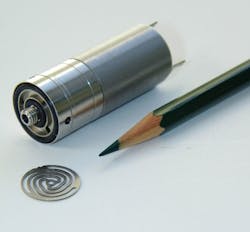Compact Valves Combine High Flow, Extreme Reliability
“More with less” is the new mantra for machine builders who rely on pneumatics. In particular, they’re demanding valves that offer ever-higher flow capacities from ever-smaller packages. This lets pneumatic systems do more work without taking up more space.
Users rely on banks of these valves to handle a variety of tasks, explains Clippard Design Engineer Dave McBreen. Applications include medical devices like blood-pressure cuffs, analytical instrumentation, gas chromatography, and leak-decay test systems. The valves can also control groups of cylinders and actuators in production and packaging machines, where they are tightly packed in multistation manifolds to minimize space requirements. Thus, the DV valve’s OD couldn’t exceed three-quarters of an inch, says McBreen.
Engineering software played a major role in the DV’s development. For instance, Clippard engineers had to design a solenoid coil that fit the available envelope and could generate enough power to shift the valve at high pressures. And response time had to be in the 10 to 15-msec range for high-speed operation. Because the engineers faced seemingly endless combinations of design variables — power levels, coil dimensions, wire gauges, and so on — the development team developed a Coil Calculator program that streamlined the design process. The software let them plug in geometry and other parameters and key in on the combinations that generated the best results.
Engineers used the Calculator along with a 3D electromagnetic field simulator program to tweak the resulting magnetic circuit and refine the coil in relatively short order, and with impressive results. The first prototype met all physical requirements and performed to within 5% of predictions, says McBreen.
The next challenge was designing flow passages that increased the valve’s capacity, but not its size. Engineers relied on both computational fluid-dynamics analysis, in this case Flow Simulation CFD from Dassault Systèmes SolidWorks, based in Waltham, Mass., and on physical testing of machined prototypes.
CFD proved an excellent tool for modeling flow through individual valves and examining various options, says McBreen. For example, certain nozzle geometries gave smoother, more-laminar conditions that resulted in consistent and higher flow. An added benefit was lower friction between the orifice and mating nozzle seal, which reduced preload and wear.
The engineering team also made extensive use of SolidWorks FEA tools in designing and analyzing the “spider,” an unusual spring that shifts the valve when the solenoid deenergizes. It measures only 0.020-in. thick by about a half inch in diameter, yet generates sufficiently high force with little movement — the DV has only 0.018 in. of stroke. Minimal stroke is necessary, says McBreen, to ensure precise control and maximum flow at operating frequencies as high as 32 Hz.
Because the valve has several working components and an extremely short stroke, part tolerances could have been an issue. “If you’re not careful, tolerance stack-up will match the stroke and the valve won’t work. The battle is, how to control those tolerances without driving manufacturing costs through the roof," states McBreen.
“It gets a little tricky, but there are certain features we can tightly control and eliminate some of the stack,” he says. That’s why parts are manufactured at Clippard’s facilities in Cincinnati. “One of our niches is being very good at machining parts with tight tolerances. We have the right equipment, we’ve been doing it for a long time, and it’s less costly than using outside vendors.”
The DV is rated for flows of 100 lpm at 50 psi with a 0.070-in. orifice, and 100 lpm at 100 psi with a 0.052-in. orifice. The valve runs on air filtered to 40 μm and is suitable for service with other compatible gases, and it is currently being tested with water. The valve base is made of 303 stainless steel, and other “wetted” materials include polyetherimide (PEI) and polyphenylene sulfide (PPS). Seals in the DV are typically Buna, but FKM, silicone, and EPDM are available on request.
Control voltages are typically 12 and 24 Vdc, and rated power consumption is 1.9 W.
Both manifold and cartridge mounting options are offered, and the valve has #10-32 ports and a 0.75-in. body. Clippard is also producing a metric version with M5 ports and a 19-mm body. A fully ported three-way version of the DV is slated for introduction this fall, and a proportional valve is in the works.
About the Author
Kenneth Korane
Ken Korane holds a B.S. Mechanical Engineering from The Ohio State University. In addition to serving as an editor at Machine Design until August 2015, his prior work experience includes product engineer at Parker Hannifin Corp. and mechanical design engineer at Euclid Inc.

